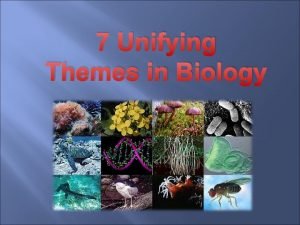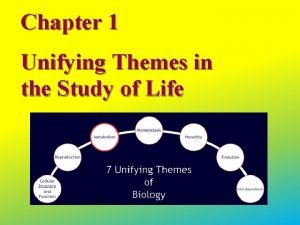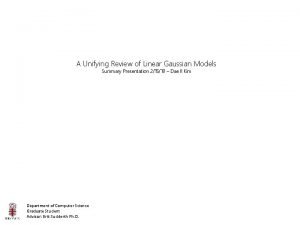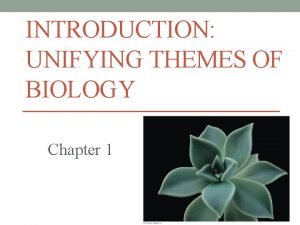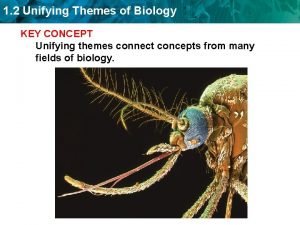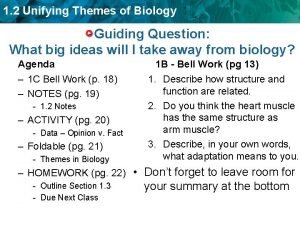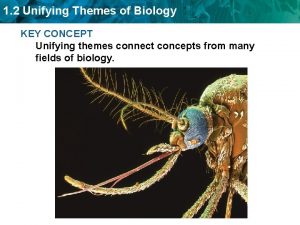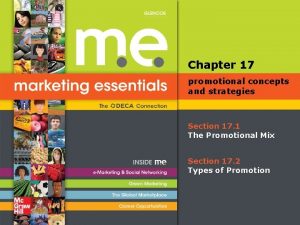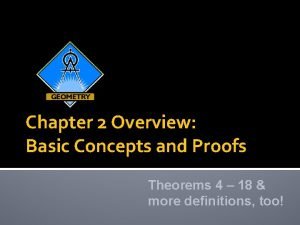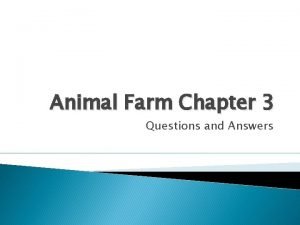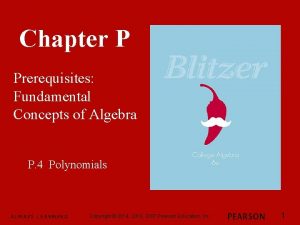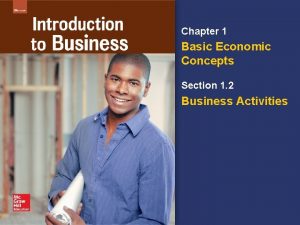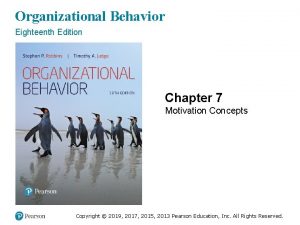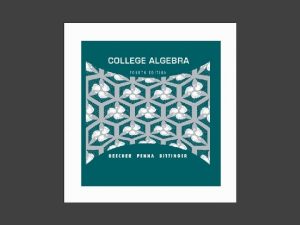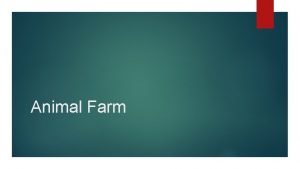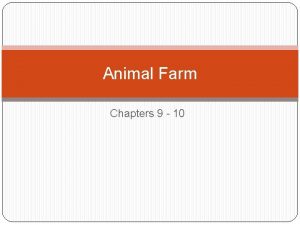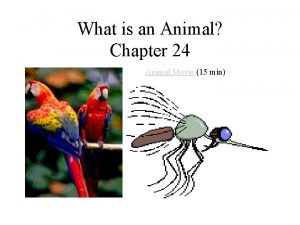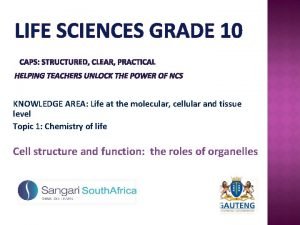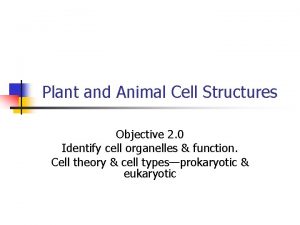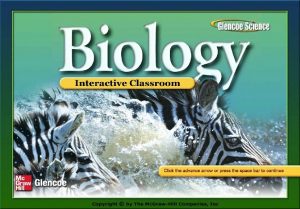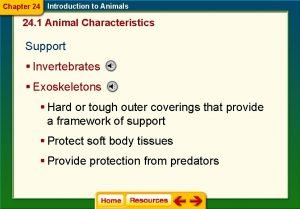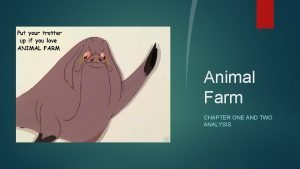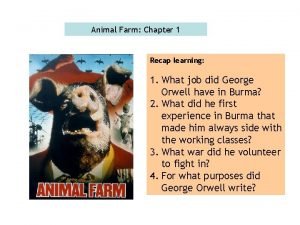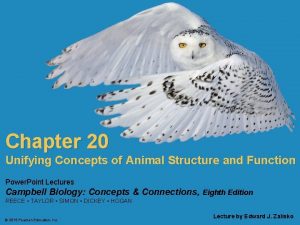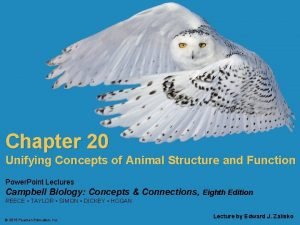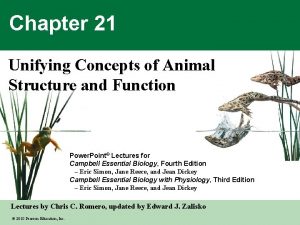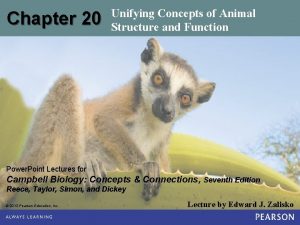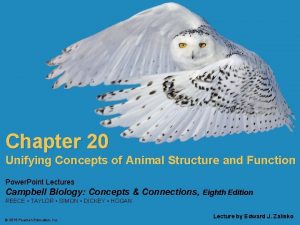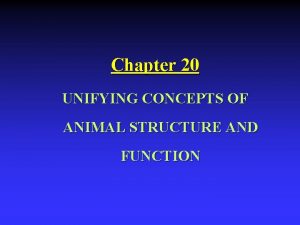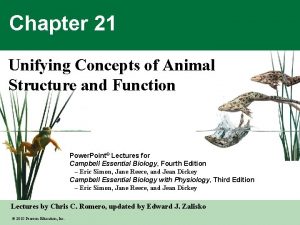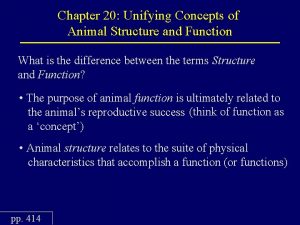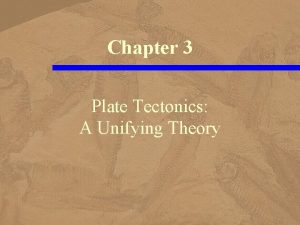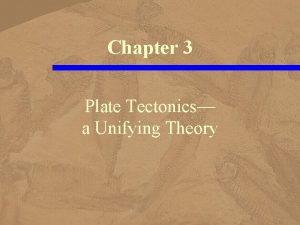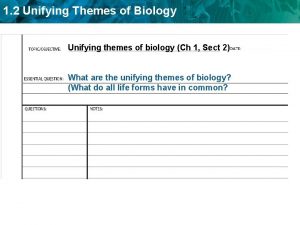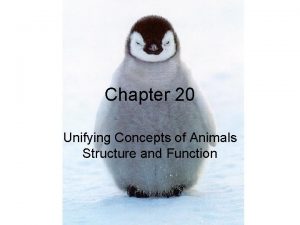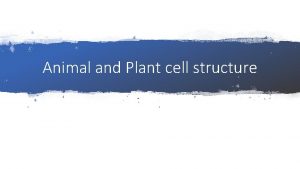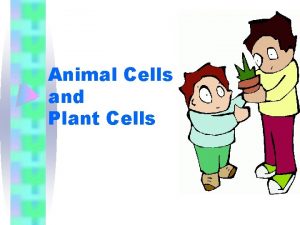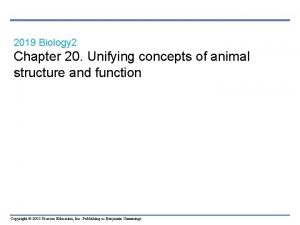Chapter 20 Unifying Concepts of Animal Structure and






































































- Slides: 70

Chapter 20: Unifying Concepts of Animal Structure and Function Campbell Biology © 2015 Pearson Education, Inc. 6 th edition

STRUCTURE AND FUNCTION IN ANIMAL TISSUES © 2015 Pearson Education, Inc.

I can… 1. Explain why evolution does not lead to _________. 2. Describe the levels of ______ in an animal’s body. 3. Describe the four main types of animal tissues. Note their structures and their functions. © 2015 Pearson Education, Inc.

20. 1 EVOLUTION CONNECTION: An animal’s form is not the _____ design • The _____ nerve of an adult giraffe travels from the brain, makes a U-turn around the aorta in the chest, and then extends back up the neck to muscles in the throat. • The throat is about 1 foot away from the brain. • Why, then, does the laryngeal nerve make about a 15 -foot journey? © 2015 Pearson Education, Inc.

20. 1 EVOLUTION CONNECTION: An animal’s form is not the perfect design • Adaptations that led to the varying lengths of the laryngeal nerve in ________ can be illustrated with an analogy. • If a table is moved away from an outlet, two options are obvious for plugging in the lamp: 1. unplug the cord and reposition the cord so that it runs _______ from the lamp to the outlet, causing a temporary loss of light, or 2. keep the cord plugged in while simply _______ the cord to reach the outlet. © 2015 Pearson Education, Inc.

20. 1 EVOLUTION CONNECTION: An animal’s form is not the perfect design • In early animal _____, the laryngeal nerve connects the brain to a rudimentary structure that • in fish will become the _______ and • in tetrapods will develop into the ____. • In these embryos, the nerve _____ under the aorta. • This is not problematic in fish because they do not have _____. • But in tetrapods, the aorta ends up in the _____, resulting in an elongated laryngeal nerve in tetrapods. • The laryngeal nerve, like all other structures, isn’t perfect – it’s just ________________! © 2015 Pearson Education, Inc.

20. 2 Structure fits function at all levels of organization in the animal body • Anatomy is the study of ______. • Physiology is the study of _____. • Animals consist of a hierarchy of ____ of organization. • _____ are an integrated group of similar cells that perform a ______ function. • _____ perform a specific task and consist of two or more ______. • ______ systems consist of ____ organs that together perform a ______ body function. © 2015 Pearson Education, Inc.

Figure 20. 2 A ______ level Muscle cell B ______ level Muscle tissue C _____ level Heart D Organ system level ________ system E Organism level Many ______ systems functioning together © 2015 Pearson Education, Inc.

20. 3 Tissues are groups of cells with a common structure and function • Tissues • are an integrated group of _______that perform a common function and combine to form ______. • Animals have four main categories of tissues: 1. _____ tissue, 2. _____ tissue, 3. _______ tissue, and 4. ____ tissue. © 2015 Pearson Education, Inc.

20. 4 Epithelial tissue ______and lines its organs and cavities • Epithelial tissues, or _____, are _______ of closely packed cells that • cover body ____ and • ______ internal organs and cavities. • Epithelial cells come in three shapes: 1. ______, like a fried egg, 2. ______, as tall as they are wide, and 3. ______, taller than they are wide. © 2015 Pearson Education, Inc.

Epithelial tissues Apical surface of epithelium Basal lamina Underlying tissue Cell nuclei A Simple squamous epithelium Thin and leaky for _______ – lining of lungs and capillaries. D Stratified squamous epithelium Many surfaces, _________ subject to abrasion (outer skin, lining of mouth and esophagus) B Simple cuboidal epithelium Large amounts of cytoplasm – secretion and absorption of materials (tubes of the kidney and lining of glands) C Simple columnar epithelium Lines the _____ – secretes digestive juices and absorbs nutrients (can have microvilli and cilia) © 2015 Pearson Education, Inc.

20. 5 Connective tissue binds and supports other tissues Connective tissue can be grouped into ____ major types. 1. Loose _____ tissue: most widespread, collagen and elastic fibers, helps to join skin to underlying tissues. 2. _____ connective tissue: densely packed collagen fibers, forms tendons that attach muscle to bone. 3. ____ tissue: stores fat in large, closely packed cells 4. _____: strong and flexible skeletal material, surrounds the ends of bones. 5. ______: _____ fibers embedded in a hard mineral substance containing ____, magnesium, and phosphate. 6. _____ transports substances throughout the body. © 2015 Pearson Education, Inc.

Connective tissues White blood cells Red blood cell Plasma Central canal Matrix F Blood Cell nucleus E Bone Collagen fiber Boneforming cells Cartilageforming cells Matrix Elastic fibers A Loose connective tissue (under the skin) D Cartilage (at the end of a bone) Cell nucleus Collagen fibers B Fibrous connective tissue (forming a tendon) © 2015 Pearson Education, Inc. Fat droplets C Adipose tissue (fat storage)

20. 6 Muscle tissue functions in movement • Muscle tissue is _____tissue in most animals. • There are _____ types of vertebrate muscle tissue: 1. ____ muscle causes _____ movements, 2. ____ muscle _______ blood, and 3. ____ muscle moves ______ of internal organs, such as the intestines. © 2015 Pearson Education, Inc.

Unit of muscle contraction Muscle fiber (cell) Nuclei A Skeletal muscle (voluntary movements) Junction between two cells Muscle fiber Nucleus B Cardiac muscle (pumps blood) Muscle fiber Nucleus Muscle tissues © 2015 Pearson Education, Inc. C Smooth muscle (moves walls of internal organs)

20. 7 Nervous tissue forms a communication network • Nervous tissue • ____ stimuli and • rapidly _____ information. • Neurons carry signals by conducting ___________. • Other cells in nervous tissue • insulate ______, • nourish neurons, and • regulate the fluid around neurons. © 2015 Pearson Education, Inc.

VIDEO “Lesson” Use earbuds and carefully view and learn! © 2015 Pearson Education, Inc.

I can… 1. Explain why evolution does not lead to perfection. 2. Describe the levels of organization in an animal’s body. 3. Describe the four main types of animal tissues. Note their structures and their functions. © 2015 Pearson Education, Inc.

Explain why evolution does not lead to perfection. © 2015 Pearson Education, Inc.

Describe the levels of organization in an animal’s body. © 2015 Pearson Education, Inc.

Describe the four main types of animal tissues. Note their structures and their functions. © 2015 Pearson Education, Inc.

20. 2 EVOLUTION CONNECTION: An animal’s form reflects natural selection The body plan or design of an organism is said to: • –reflect the relationship between ____ and _______, • –result from natural ____, and • –not imply a process of _________. Streamlined and tapered bodies are proposed to: • –increase _____ speeds and • –have similarly evolved in fish, sharks, and aquatic birds and mammals, representing _____ evolution. © 2015 Pearson Education, Inc.

ORGANS AND ORGAN SYSTEMS © 2015 Pearson Education, Inc.

I can… 1. Explain how the structure of organs is based on the ______ interactions of _____. 2. Explain how _______ systems work together to perform life’s functions. 3. Describe the general structures and functions of the ____ major vertebrate organ _____. 4. Describe the components of well-designed scientific _____. © 2015 Pearson Education, Inc.

20. 8 Organs are made up of tissues • An organ is a group of tissues __________. • Organs perform functions that ______ ___ ____ tissues can carry out _____. • Example: the heart has • extensive muscle that generates ______, • epithelial tissues that • line the heart chambers, • prevent ____, and • form a ____ surface for blood ______, • connective tissues that make the heart _______ and strong, and • _______ that regulate contractions. © 2015 Pearson Education, Inc.

20. 9 CONNECTION: Bioengineers are learning to produce organs for transplants • Bioengineering is seeking ways to repair or ______ damaged tissues and organs. • New tissues and organs are being grown on a scaffold of ____ tissue from donated organs. • Other researchers are using desktop printers to create layers of different cells ____ the structure of organs. © 2015 Pearson Education, Inc.

What is Bioengineering? © 2015 Pearson Education, Inc.

Career Spotlight: Bioengineer © 2015 Pearson Education, Inc.

Bioengineering in Action! © 2015 Pearson Education, Inc.

20. 10 Organ systems work together to perform life’s functions • Each organ system typically consists of many ______, has one or more functions, and works with other organ _____ to create a functional organism. © 2015 Pearson Education, Inc.

© 2015 Pearson Education, Inc.

20. 10 Organ systems work together to perform life’s functions • The circulatory system delivers _______ and nutrients to body cells, transports ___2 to the lungs, and carries metabolic ______ to the kidneys. • The respiratory system _____ gases, supplying the blood with oxygen and disposing of carbon dioxide. © 2015 Pearson Education, Inc.

20. 10 Organ systems work together to perform life’s functions • The ______ system protects against • • physical injury, _____, excessive _____ or cold, and ______ out. © 2015 Pearson Education, Inc.

20. 10 Organ systems work together to perform life’s functions • The skeletal system • _______ the body, • _______ organs such as the brain and lungs, and • provides the _____ for muscle movement. © 2015 Pearson Education, Inc.

20. 10 Organ systems work together to perform life’s functions • The ______ system • moves the body, maintains ____, and ________. © 2015 Pearson Education, Inc.

20. 10 Organ systems work together to perform life’s functions • The urinary system • removes _______ products from the blood, • _____ urine, and • ____ the chemical makeup, ___, and water balance of blood. • The _____ system • ______ and digests food, • _______ nutrients, and • _____ undigested material. © 2015 Pearson Education, Inc.

20. 10 Organ systems work together to perform life’s functions • The endocrine system secretes ____ that regulate body activities. © 2015 Pearson Education, Inc.

20. 10 Organ systems work together to perform life’s functions • The lymphatic and immune systems protect the body from _____ and cancer. • The ______ system also returns excess ____to the circulatory system. © 2015 Pearson Education, Inc.

20. 10 Organ systems work together to perform life’s functions • The _______ system coordinates body activities by • detecting _______, • ____ information, and • directing ____. © 2015 Pearson Education, Inc.

20. 10 Organ systems work together to perform life’s functions • The reproductive system produces • _______ and • ____ hormones. • The female reproductive system • supports a developing _____ and • produces _____. © 2015 Pearson Education, Inc.

20. 11 The integumentary system protects the body • The skin consists of two layers. 1. The _____ • ______ physical damage, • decreases water ____, and • prevents penetration by _____. 2. The dermis • ______ sensory information, • synthesizes ____, and • helps regulate body ______. © 2015 Pearson Education, Inc.

Organs and Organ Systems © 2015 Pearson Education, Inc.

I can… 1. Explain how the structure of organs is based on the cooperative interactions of tissues. 2. Explain how organ systems work together to perform life’s functions. 3. Describe the general structures and functions of the 12 major vertebrate organ systems. © 2015 Pearson Education, Inc.

Explain how the structure of organs is based on the cooperative interactions of tissues. © 2015 Pearson Education, Inc.

Explain how organ systems work together to perform life’s functions. © 2015 Pearson Education, Inc.

Describe the general structures and functions of the 12 major vertebrate organ systems. © 2015 Pearson Education, Inc.

Explain how the structure of organs is based on the cooperative interactions of tissues. © 2015 Pearson Education, Inc.

20. 12 SCIENTIFIC THINKING: Well-designed studies help answer scientific questions • As consumers, we are bombarded with claims daily. • To make _____ decisions and behave as responsible consumers, we should _____ information as scientists do. • For example, consider claims for acne treatment. © 2015 Pearson Education, Inc.

20. 12 SCIENTIFIC THINKING: Well-designed studies help answer scientific questions • Acne results when the hair follicles that produce ____ become ____ with dead cells and oil. • When the pore is plugged, _____ of the species Propionibacterium acnes (P. acnes) become trapped in the _____. • If the follicle ruptures into the dermis and _____are recruited from the immune system, the pore is said to be _______ in what we commonly call a “______” or “zit. ” © 2015 Pearson Education, Inc.

20. 12 SCIENTIFIC THINKING: Well-designed studies help answer scientific questions • Consider a study involving 19 individuals, all chosen because they had at least five pimples. • After three laser treatments, all participants had a significant reduction in the total number of pimples. © 2015 Pearson Education, Inc.

20. 12 Well-designed studies help answer scientific questions • But the study did not have a _______ group that could reveal if individuals who had undergone laser therapy _____had the same reduction in pimples if they had _____ had the procedure. • The study also failed to control _____. The participants were allowed to continue using acne medications over the course of the study. • These data indicate that laser therapy is _______ effective – decreasing red pimples for a few weeks. © 2015 Pearson Education, Inc.

© 2015 Pearson Education, Inc.

I can…Describe the components of welldesigned scientific studies. © 2015 Pearson Education, Inc.

Scientific Design and Interpretation is Vital © 2015 Pearson Education, Inc.

You need to THINK about What Statistics Says © 2015 Pearson Education, Inc.

Is Your Data Tricking You? © 2015 Pearson Education, Inc.

What is “Simpson’s Paradox”? Explain © 2015 Pearson Education, Inc.

EXTERNAL EXCHANGE AND INTERNAL REGULATION © 2015 Pearson Education, Inc.

I can. . 1. Describe the systems that help an animal exchange materials with its environment. 2. Define the concept of homeostasis and illustrate it with examples. 3. Explain how negative feedback is used to regulate internal body temperature. © 2015 Pearson Education, Inc.

20. 13 Structural adaptations enhance exchange with the environment Every organism is an ______ that must exchange matter and energy with its surroundings. Respiratory system: Exchanges gases between the _______ environment and ____. Digestive system: acquires food and eliminates wastes. Urinary system: eliminates metabolic waste Circulatory system: distributes gases, nutrients, and wastes throughout the body and exchanges materials between blood and body cells © 2015 Pearson Education, Inc.

20. 14 Animals regulate their internal environment • _______ is the active maintenance of a steady state within the body. • External environmental conditions may fluctuate wildly. • Homeostatic mechanisms _____ conditions. © 2015 Pearson Education, Inc.

20. 15 Homeostasis depends on negative feedback • _____-feedback: when a change in a variable triggers mechanisms that ______ that change. • mechanisms keep internal variables ______ and • ______ only small _______ around set points. Too cold? Too hot? © 2015 Pearson Education, Inc.

© 2015 Pearson Education, Inc.

REVIEW! © 2015 Pearson Education, Inc.

You should now be able to 1. Explain why evolution does not lead to perfection. 2. Describe the levels of organization in an animal’s body. 3. Describe the four main types of animal tissues. Note their structures and their functions. 4. Explain how the structure of organs is based on the cooperative interactions of tissues. © 2015 Pearson Education, Inc.

You should now be able to 5. Explain how artificial tissues and organs are being created in laboratories. 6. Explain how organ systems work together to perform life’s functions. 7. Describe the general structures and functions of the 12 major vertebrate organ systems. 8. Relate the structure of the skin to its functions. © 2015 Pearson Education, Inc.

You should now be able to 9. Describe the components of well-designed scientific studies. 10. Describe the systems that help an animal exchange materials with its environment. 11. Define the concept of homeostasis and illustrate it with examples. 12. Explain how negative feedback is used to regulate internal body temperature. © 2015 Pearson Education, Inc.

Example Structure Function Figure 20. UN 02 20. 4 Epithelial tissue covers the body and lines its organs and cavities. 20. 5 Connective tissue binds and supports other tissues. 20. 6 Muscle tissue functions in movement. 20. 7 Nervous tissue forms a communication network. Sheets of closely packed cells Sparse cells in extracellular matrix Long cells (fibers) with contractile proteins Neurons with branching extensions; supporting cells Columnar epithelium © 2015 Pearson Education, Inc. Loose connective tissue Skeletal muscle Neuron

Figure 20. UN 03 a. ______ a. b. ______ b. c. _______ d. _______ e. _______ © 2015 Pearson Education, Inc. c. d. e.

Textbook: Biology, by Campbell • Carefully read Chapter 20 (13 pages) – Take notes as needed (you need to have an understanding of the chapter) – Review the concepts in Chapter Review – Finally, in your notebook complete the Connection the Concepts/TESTING YOUR KNOWLEDGE (write out questions WITH correction answers [only]. © 2015 Pearson Education, Inc.
 Unifying concepts of animal structure and function
Unifying concepts of animal structure and function Archegoniates
Archegoniates 7 unifying themes of biology
7 unifying themes of biology Concept map about unifying themes about life
Concept map about unifying themes about life A unifying review of linear gaussian models
A unifying review of linear gaussian models Unifying theory of plate tectonics
Unifying theory of plate tectonics 4 unifying themes of biology
4 unifying themes of biology 5 unifying themes of biology
5 unifying themes of biology Unifying theme definition
Unifying theme definition Unifying healthcare data
Unifying healthcare data 5 unifying themes of biology
5 unifying themes of biology Zhiting hu
Zhiting hu Plant cell animal cell venn diagram
Plant cell animal cell venn diagram Animal rights versus animal welfare
Animal rights versus animal welfare Animal cell and plant cell venn diagram
Animal cell and plant cell venn diagram Chapter 17 promotional concepts and strategies
Chapter 17 promotional concepts and strategies Contrast trade promotions and consumer sales promotions
Contrast trade promotions and consumer sales promotions Chapter 2 analyzing transactions answer key
Chapter 2 analyzing transactions answer key Reviewing concepts and vocabulary chapter 1
Reviewing concepts and vocabulary chapter 1 Chapter 2 basic concepts and proofs answers
Chapter 2 basic concepts and proofs answers Introduction and mathematical concepts
Introduction and mathematical concepts Relevant range managerial accounting
Relevant range managerial accounting Chapter 1 managerial accounting and cost concepts
Chapter 1 managerial accounting and cost concepts Animal farm chapter 1-3 questions and answers pdf
Animal farm chapter 1-3 questions and answers pdf Is cytoplasm in plant and animal cells
Is cytoplasm in plant and animal cells Chapter 33 entrepreneurial concepts answers
Chapter 33 entrepreneurial concepts answers Chapter 15 developing fraction concepts
Chapter 15 developing fraction concepts A survey of probability concepts
A survey of probability concepts Section 3 basic concepts of democracy
Section 3 basic concepts of democracy P+p+p+p algebra
P+p+p+p algebra Chapter p prerequisites fundamental concepts of algebra
Chapter p prerequisites fundamental concepts of algebra Chapter p prerequisites
Chapter p prerequisites Chapter 1 activity basic concepts
Chapter 1 activity basic concepts Criminal law and juvenile justice unit 2
Criminal law and juvenile justice unit 2 Organizational behavior chapter 7
Organizational behavior chapter 7 Chapter r basic concepts of algebra answers
Chapter r basic concepts of algebra answers Chapter 8 bonding general concepts answers
Chapter 8 bonding general concepts answers Operating system concepts chapter 8 solutions
Operating system concepts chapter 8 solutions Operating system concepts chapter 5 solutions
Operating system concepts chapter 5 solutions Operating system concepts chapter 5 solutions
Operating system concepts chapter 5 solutions Chapter 4 accrual accounting concepts
Chapter 4 accrual accounting concepts Chapter 2 basic marketing concepts
Chapter 2 basic marketing concepts Basic concepts of democracy chapter 1 section 3
Basic concepts of democracy chapter 1 section 3 A survey of probability concepts chapter 5 solutions
A survey of probability concepts chapter 5 solutions Chapter concepts vocabulary
Chapter concepts vocabulary Chapter 7 motivation concepts
Chapter 7 motivation concepts Secam stands for
Secam stands for Accrual accounting principles
Accrual accounting principles Animal farm summary chapter 1
Animal farm summary chapter 1 Animal farm chapter 7 and 8 summary
Animal farm chapter 7 and 8 summary Animal farm summary chapter 9
Animal farm summary chapter 9 Coral reef phylum
Coral reef phylum Animal cell under microscope
Animal cell under microscope What does it mean
What does it mean Animal crll
Animal crll Spontaneous generation in data flow diagram
Spontaneous generation in data flow diagram Dfd chapter 5
Dfd chapter 5 Structural ambiguity
Structural ambiguity Linguistics
Linguistics Surface structure and deep structure
Surface structure and deep structure Static data structures
Static data structures Deep and surface structure in linguistics
Deep and surface structure in linguistics Animal farm narrator
Animal farm narrator Chapter 51: animal behavior
Chapter 51: animal behavior Chapter 24 section 3 sponges and cnidarians
Chapter 24 section 3 sponges and cnidarians Introduction to animals section 1 animal characteristics
Introduction to animals section 1 animal characteristics Animal farm chapter 1 theme
Animal farm chapter 1 theme Animal farm summary chapter 8
Animal farm summary chapter 8 Why did mollie leave the farm
Why did mollie leave the farm Summary of animal farm
Summary of animal farm Hyperbole in animal farm chapter 1
Hyperbole in animal farm chapter 1

